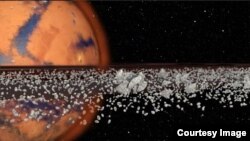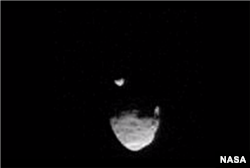Mars may have had Saturn-like rings in the past and may have them again, a new study suggests.
According to models developed by researchers at Purdue University, the Red Planet was likely hit by an asteroid or other body about 4.3 billion years ago. The debris from the impact might have become a ring before accreting and becoming a moon.
Researchers have long theorized that the planet’s North Polar Basin or Borealis basin was created by the impact. The basin covers about 40 percent of the planet’s surface.
"That large impact would have blasted enough material off the surface of Mars to form a ring," said Andrew Hesselbrock, a doctoral student at Purdue who helped develop the model.
After forming a moon, researchers think Mars’ gravity would start to pull the moon closer and closer to the planet. At some point, however, the Martian gravity would “break apart” the moon, researchers theorize.
In fact, Phobos, one of Mars’ two moons (Deimos is the other), is getting closer to the Red Planet, and researchers think that in about 70 million years, it will break apart, potentially creating more rings. This cycle, researchers think, could have repeated over billions of years.
With each successive iteration, researchers think successor moons would have been five times smaller than the previous moon, with some debris raining down on the Martian surface. There are unexplained sedimentary deposits near the planet’s equator, researchers say.
"You could have had kilometer-thick piles of moon sediment raining down on Mars in the early parts of the planet's history, and there are enigmatic sedimentary deposits on Mars with no explanation as to how they got there," said Purdue's David Minton, assistant professor of Earth, atmospheric and planetary sciences. "And now it's possible to study that material."
The study was published in the journal Nature Geoscience.

